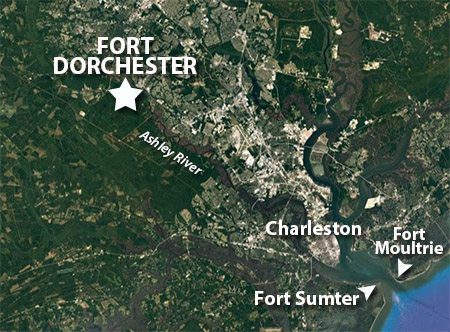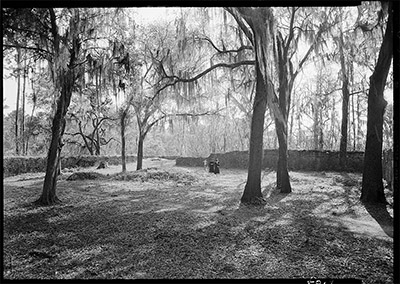 |
Fort Dorchester
Summerville, South Carolina, USA
|
|
 |
Constructed: 1757-1760
Used by: Great Britain,
United States
Conflict in which it participated:
French and Indian War,
American Revolutionary War
|
Fort Dorchester was a French and Indian War armed magazine, built along the banks of the Ashley River to safeguard British powder stores from nearby Charleston. Its distinctive "half bastions" make it look extremely similar to Magazine Fort in Dublin, Ireland (click here to see the comparison) ...built at a similar time, by the same folks and for the exact same purpose...but half a world apart. |
 |

|
|
1696 brought a small group of settlers to the banks of the Ashley River in what is today South Carolina. They were from a small town in Massachusetts called Dorchester, and they came with the intention of "settling the gospel." Under the direction of Reverend Joseph Lord (1672-1748), they built the St. George Anglican Church (completed in 1719), and the town of Dorchester was established around it.
|
What's left of St. George Anglican Church today: Its bell tower, which was added in 1751. |
 |
Dorchester became a thriving, buzzing hub of commerce. Located just to the northwest of the large colonial city of Charles Town, Dorchestarians carried on a brisk trade with that community, as well as with the local Indians. By the mid-18th century, Dorchester was at its peak of agricultural prosperity, but Europe's incessant wars, those which the New World's colonists had worked so hard to escape, had a long reach. Great Britain and France began openly fighting over disputed regions in North America in 1754, while in Europe, Prussia overran Saxony in 1756. All the European powers partnered up and kicked off the Seven Years' War (1756-1763), which spilled over into the New World as the French and Indian War (1754-1763). Great Britain ultimately prevailed in this conflict, but in 1757 things were looking bright for the French. Troops led by Louis-Joseph de Montcalm (1712-1759) had destroyed Fort Ontario on Lake Ontario in August of 1756, and captured Fort William Henry on Lake George the following August. Neither of which were anywhere near Charleston, but the British Garrison in Charles Town was understandably alarmed by the possibility of French attack. The only British powder magazine in colonial South Carolina was in Charles Town, so a plan was developed to build a fortified magazine at a remove from the city, but close enough to quickly supply the garrison. |
|
|
As one may have guessed, Dorchester was that place. With several decent roads leading betwixt Dorchester and Charles Town, plus the immediate presence of the Ashley River (at high tide, ships as large as "two-masted sailing vessels" could navigate the Ashley), the transport of gunpowder would be a straightforward enterprise.
Initially planned to be made of brick, the fortified magazine that would become Fort Dorchester was instead made with tabby, a building material consisting of lime, oyster shells and sand, popular in coastal areas in the 1700's because it was relatively cheap and easy to manipulate...particularly when one had slaves doing all the work. Thanks, slaves.
Fort Dorchester wasn't actually called Fort Dorchester until much later...it had no official name, and was likely referred to as the Magazine at Dorchester.
|
The purpose of Fort Dorchester was its powder magazine, which was an oblong brick structure at the center of the fort's eight-foot-high tabby walls. For some reason, the "half-bastion" concept was deemed sufficient for the defense of a powder magazine by the British military: I've only seen two such completely "half-bastioned" forts in my studies thus far, which I'll admit isn't much of a basis for conviction, but they've both been for the protection of magazines.
Sadly, the French invasion of Charleston never took place, so the French did not get an opportunity to admire Fort Dorchester.
|
 |
Fort Dorchester's tabby walls and one of its adorable little guns today. |
|
The Seven Years' War nearly doubled Great Britain's national debt, leading King George III (1738-1820) to the logical conclusion that he could cover at least some of his expenses by taxing the Colonists that the redcoats had fought to defend. Wrong! Would-be Americans would not be taxed by a vicious overseas tyrant, regardless of how justified those taxes might be!
|
 A shot of Fort Dorchester's interior from LOC.gov, which is, as I believe I may have pointed out once or twice in the past, an incredible resource. The date of this picture is vaguely stated as, "prior to 1933." |
 |
The American Revolutionary War (1775-1783) brought much activity to Dorchester. The little town served as a depot and gathering place for Patriot troops, and Fort Dorchester was further fortified. Fort Dorchester's commanding officer at this time was Francis Marion (1732-1795) who, after Charleston was captured by the British in May of 1780, fled from Dorchester and "took to the hills" ("hills" in this case means "swamp"). Marion and friends waged a guerilla campaign against the British, earning him the sobriquet of the Swamp Fox.Marion would later become starfort royalty when the Castillo de San Marcos was renamed Fort Marion in his honor, upon its acquisition by the United States in 1821. |
|
|
Fort Dorchester and its namesake town were taken over by British and Loyalist troops until December of 1781, when they were driven shrieking into the swamp by American troops under General Nathanael Greene (1742-1786). After the war, Fort Dorchester's magazine was converted into a kiln, and the fort was relegated to the unmartial activity of turning out clay roofing tiles.
By the end of the 18th century, Fort Dorchester and the town had been abandoned, their history forgotten. By the time people finally stumbled upon the overgrown Fort Dorchester, it was thought that it had been built by the Spanish (a reasonable assumption given the material from which the fort's walls had been made), and/or that it had been constructed to provide protection from Indians. It was at this time that those locals who had rediscovered it, first called it Fort Dorchester!
|
From December of 1901 to June of 1902, the South Carolina Inter-State and West Indian Exposition was held along the banks of the Ashley River in Charleston. This fair was intended to promote trade with the Caribbean and Latin America, and attracted such bigwigs as the 26th President of the United States, Theodore Roosevelt (1858-1919). While visiting the fair in 1902, Teddy and his entourage took a side trip to Fort Dorchester, where they doubtless shook their heads and chortled at the silly fortbuilding practices of the Spanish.
The town of Summerville grew on nearby higher, better-drained land, utilizing Dorchester's unused building materials for some of its structures.
Today the remains of the St. George Anglican Church's graveyard and bell tower, plus the foundations of a few houses are all that remain of Dorchester...but the fort's walls are in relatively pristine condition (albethey a sooty black color), and the structure is considered one of the best remaining examples of a tabby fort in the United States.
|
 |
President Theodore Roosevelt standing atop the delicate tabby walls of Fort Dorchester in 1902. This is one half of a stereoscopic image (why would anyone want to see a jumble of white people standing on a fort in stereo? I don't know, ask a stereoscopist), click it to see the whole thing! |
|
Countless thanks to Fortwiki.com for pointing me towards Fort Dorchester! |
|
|
|
|
|
|
 |




